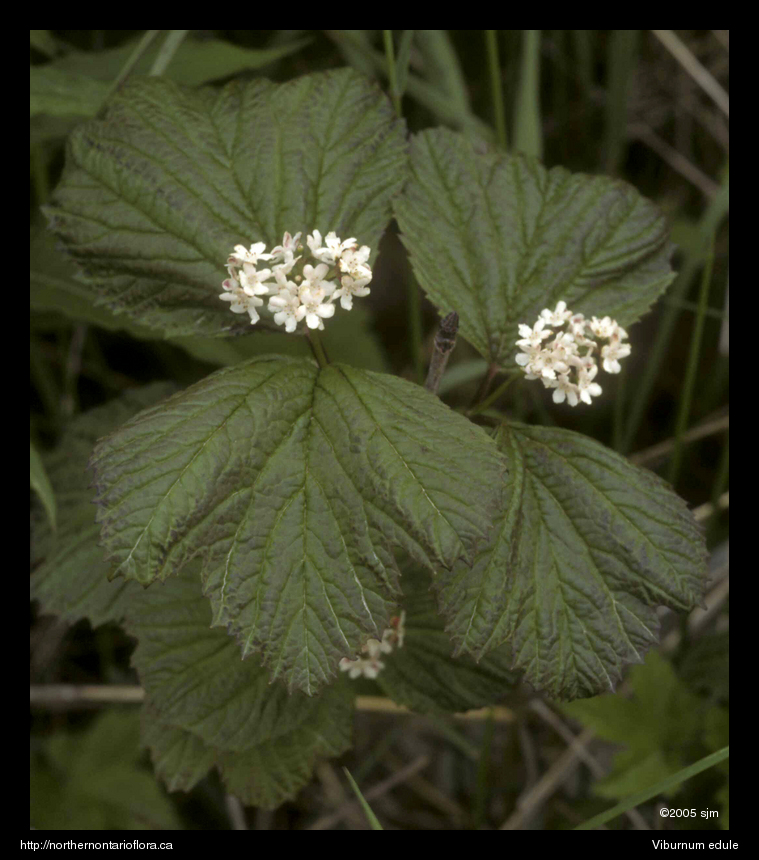
|
Northern Ontario Plant Database 
Plant DescriptionViburnum edule (Michx.) Raf.En: squashberry, mooseberry, lowbush cranberry, highbush cranberry (wCan)
Adoxaceae (Viburnum Family) General: A spreading to erect, deciduous shrub, to about 2 m tall. Branches smooth (glabrous); terminal buds present, bud scales 2, dark red, valvate. Leaves: Opposite, simple, petiolate. Leaf blade 4-12 cm long; smooth and dark green above, paler below, with short hairs along the veins; margins dentate to serrate; usually bearing a pair of small glands at the base of the blade near the petiole. Leaves of two forms: upper leaf pairs elliptic to ovate, unlobed or barely 3-lobed, with pinnate venation, base blunt to rounded, apex acute to acuminate; lower leaf pairs broader, 3-lobed, palmately-veined, with 3 to 5 major veins; base rounded to truncate, apex acute. Fertile branches bear just 2 leaves, these smaller than leaves of the new year's growth. Flowers: Bisexual, milky white, tinged with pink beneath, arranged in few-flowered clusters (cymes), 1.5-2.5+ cm across, terminal on lateral branches arising from the previous year's growth. All flowers of the inflorescence are fertile and of approximately the same size. Calyx small, inconspicuous; corolla 5-lobed; stamens 5, adnate to the corolla, not extending beyond the corolla tube; the ovary inferior. Flowers bloom in early summer. Fruit: An ovoid, yellow (when immature) to orange-red, berry-like drupe, 6-12 mm long, with one flat seed inside the stony pit. Edible, juicy and tart, usually used in making jam. The ripe fruits of squashberry have a strong musky smell that persists through cooking, but is absent in the resulting jams and jellies. Fruits ripen in mid to late summer. Habitat and Range: Damp woods and thickets, wet clearing, peatlands, along shorelines and streambanks; throughout northern Ontario, extending from Hudson Bay south to about 48° N, along the northern Lake Superior shore (Soper & Heimburger 1982). Viburnum edule is native to boreal North America. Similar Species: The 3-lobed leaves of Viburnum edule may be mistaken for those of Viburnum opulus var. americanum (highbush cranberry), but the latter shrub has leaf margins with few, coarse rounded teeth and large, terminal cymes with many small, fertile flowers surrounded by a few large, showy, sterile flowers. See the Viburnum opulus var. americanum page. Internet Images: This webpage on Viburnum edule from the Perennial Gardening on the Prairies (Regina, Saskatchewan) website, clearly shows the location of the inflorescences, which are terminal on lateral 2-leaved branches originating from the previous year's growth. This webpage on Viburnum edule is from the New Brunswick Tree and Shrub Species of Concern, from the Atlantic Forestry Centre, Fredericton, NB. Information on traditional uses of squashberry (called highbush cranberry in western Canada) by the Gitxsan and Wet'suwet'en peoples of British Columbia can be found on the website "Traditional Plant Use in the Hazeltons." Back to species list |
||||||||||||||||||||||












